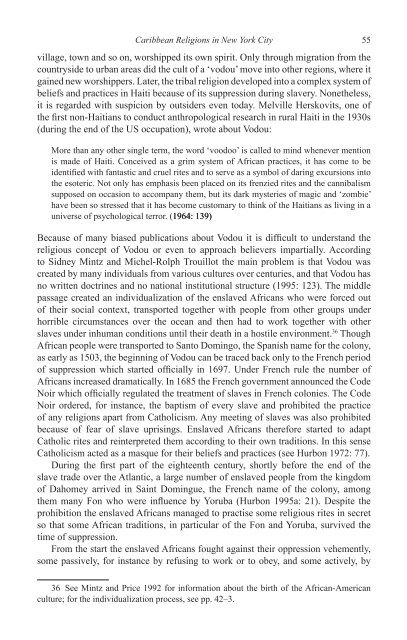Create successful ePaper yourself
Turn your PDF publications into a flip-book with our unique Google optimized e-Paper software.
<strong>Caribbean</strong> <strong>Religions</strong> <strong>in</strong> <strong>New</strong> <strong>York</strong> <strong>City</strong> 55<br />
village, town and so on, worshipped its own spirit. Only through migration from <strong>the</strong><br />
countryside to urban areas did <strong>the</strong> cult <strong>of</strong> a ‘vodou’ move <strong>in</strong>to o<strong>the</strong>r regions, where it<br />
ga<strong>in</strong>ed new worshippers. Later, <strong>the</strong> tribal religion developed <strong>in</strong>to a complex system <strong>of</strong><br />
beliefs and practices <strong>in</strong> Haiti because <strong>of</strong> its suppression dur<strong>in</strong>g slavery. None<strong>the</strong>less,<br />
it is regarded with suspicion by outsiders even today. Melville Herskovits, one <strong>of</strong><br />
<strong>the</strong> first non-Haitians to conduct anthropological research <strong>in</strong> rural Haiti <strong>in</strong> <strong>the</strong> 1930s<br />
(dur<strong>in</strong>g <strong>the</strong> end <strong>of</strong> <strong>the</strong> US occupation), wrote about Vodou:<br />
More than any o<strong>the</strong>r s<strong>in</strong>gle term, <strong>the</strong> word ‘voodoo’ is called to m<strong>in</strong>d whenever mention<br />
is made <strong>of</strong> Haiti. Conceived as a grim system <strong>of</strong> African practices, it has come to be<br />
identified with fantastic and cruel rites and to serve as a symbol <strong>of</strong> dar<strong>in</strong>g excursions <strong>in</strong>to<br />
<strong>the</strong> esoteric. Not only has emphasis been placed on its frenzied rites and <strong>the</strong> cannibalism<br />
supposed on occasion to accompany <strong>the</strong>m, but its dark mysteries <strong>of</strong> magic and ‘zombie’<br />
have been so stressed that it has become customary to th<strong>in</strong>k <strong>of</strong> <strong>the</strong> Haitians as liv<strong>in</strong>g <strong>in</strong> a<br />
universe <strong>of</strong> psychological terror. (1964: 139)<br />
Because <strong>of</strong> many biased publications about Vodou it is difficult to understand <strong>the</strong><br />
religious concept <strong>of</strong> Vodou or even to approach believers impartially. Accord<strong>in</strong>g<br />
to Sidney M<strong>in</strong>tz and Michel-Rolph Trouillot <strong>the</strong> ma<strong>in</strong> problem is that Vodou was<br />
created by many <strong>in</strong>dividuals from various cultures over centuries, and that Vodou has<br />
no written doctr<strong>in</strong>es and no national <strong>in</strong>stitutional structure (1995: 123). The middle<br />
passage created an <strong>in</strong>dividualization <strong>of</strong> <strong>the</strong> enslaved Africans who were forced out<br />
<strong>of</strong> <strong>the</strong>ir social context, transported toge<strong>the</strong>r with people from o<strong>the</strong>r groups under<br />
horrible circumstances over <strong>the</strong> ocean and <strong>the</strong>n had to work toge<strong>the</strong>r with o<strong>the</strong>r<br />
slaves under <strong>in</strong>human conditions until <strong>the</strong>ir death <strong>in</strong> a hostile environment. 36 Though<br />
African people were transported to Santo Dom<strong>in</strong>go, <strong>the</strong> Spanish name for <strong>the</strong> colony,<br />
as early as 1503, <strong>the</strong> beg<strong>in</strong>n<strong>in</strong>g <strong>of</strong> Vodou can be traced back only to <strong>the</strong> French period<br />
<strong>of</strong> suppression which started <strong>of</strong>ficially <strong>in</strong> 1697. Under French rule <strong>the</strong> number <strong>of</strong><br />
Africans <strong>in</strong>creased dramatically. In 1685 <strong>the</strong> French government announced <strong>the</strong> Code<br />
Noir which <strong>of</strong>ficially regulated <strong>the</strong> treatment <strong>of</strong> slaves <strong>in</strong> French colonies. The Code<br />
Noir ordered, for <strong>in</strong>stance, <strong>the</strong> baptism <strong>of</strong> every slave and prohibited <strong>the</strong> practice<br />
<strong>of</strong> any religions apart from Catholicism. Any meet<strong>in</strong>g <strong>of</strong> slaves was also prohibited<br />
because <strong>of</strong> fear <strong>of</strong> slave upris<strong>in</strong>gs. Enslaved Africans <strong>the</strong>refore started to adapt<br />
Catholic rites and re<strong>in</strong>terpreted <strong>the</strong>m accord<strong>in</strong>g to <strong>the</strong>ir own traditions. In this sense<br />
Catholicism acted as a masque for <strong>the</strong>ir beliefs and practices (see Hurbon 1972: 77).<br />
Dur<strong>in</strong>g <strong>the</strong> first part <strong>of</strong> <strong>the</strong> eighteenth century, shortly before <strong>the</strong> end <strong>of</strong> <strong>the</strong><br />
slave trade over <strong>the</strong> Atlantic, a large number <strong>of</strong> enslaved people from <strong>the</strong> k<strong>in</strong>gdom<br />
<strong>of</strong> Dahomey arrived <strong>in</strong> Sa<strong>in</strong>t Dom<strong>in</strong>gue, <strong>the</strong> French name <strong>of</strong> <strong>the</strong> colony, among<br />
<strong>the</strong>m many Fon who were <strong>in</strong>fluence by Yoruba (Hurbon 1995a: 21). Despite <strong>the</strong><br />
prohibition <strong>the</strong> enslaved Africans managed to practise some religious rites <strong>in</strong> secret<br />
so that some African traditions, <strong>in</strong> particular <strong>of</strong> <strong>the</strong> Fon and Yoruba, survived <strong>the</strong><br />
time <strong>of</strong> suppression.<br />
From <strong>the</strong> start <strong>the</strong> enslaved Africans fought aga<strong>in</strong>st <strong>the</strong>ir oppression vehemently,<br />
some passively, for <strong>in</strong>stance by refus<strong>in</strong>g to work or to obey, and some actively, by<br />
36 See M<strong>in</strong>tz and Price 1992 for <strong>in</strong>formation about <strong>the</strong> birth <strong>of</strong> <strong>the</strong> African-American<br />
culture; for <strong>the</strong> <strong>in</strong>dividualization process, see pp. 42–3.


















